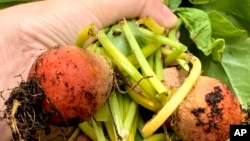If you live in areas of temperate climate and enjoy homegrown vegetables, it is time to start planting now.
A temperate climate area is a part of Earth that lies between 40 to 60 degrees north or south of the Equator.
Gardening expert Jessica Damiano writes for the Associated Press. She says if you live in a temperate area, start planting cool weather crops now and you will enjoy the fruits of your labor by November.
The process for starting seeds and planting starter plants is the same year-round. But when planting crops for autumn in areas that experience frosts and freezes, timing needs to be exact. If you plant cool weather crops too early, they might not grow well under the summer sun. If you are too late, the cold weather could kill them before they are fully grown.
To get it right, you will need to know the average date of the first frost in your area. That is the time when the ground will harden and ice will form overnight.
Next, count backward from your first frost date by the number of days the individual crops will be fully grown. And use that target date as a starting point.
There are some exceptions. In the southernmost temperate areas, for example, you can still plant summer vegetables like tomatoes, eggplants, peppers, squash and beans in August and September. But cool-weather crops should wait until October or November.
Crops for cool weather
Greens like arugula, Asian greens, collards, kale, lettuces, mustard greens, spinach and Swiss chard – and root crops like beets, radishes and parsnips – grow well in the cool temperatures and limited daylight of the autumn season.
Their seeds can be put directly into the garden or outdoor containers in most areas. But it is better to start these seeds indoors with cooler temperatures over hot summer weather.
Work with the soil before seeding or transplanting. Add generous amounts of organic matter like compost or aged manure to garden soil. Mix in a slow-release fertilizer also. If you are planting root crops, loosen the soil 25 to 30 centimeters deep to ease their growth downward.
Plant the seeds at the depth of about twice their width. Space them out to avoid overcrowding. Keep the soil wet but be careful to avoid washing away seeds. And, firmly but gently pack the soil into place. If seeds are tiny, you can spread them over the soil and then remove extra growths to avoid crowding out the plants.
After the seeds develop, apply mulch to retain water in the soil to keep the temperature even. This can also block undesirable plants called weeds from taking over the area. Pull up any weeds that you find as they take water and nutrients that your crop needs. Keep plants well-watered during the remaining summer months to protect them from heat damage.
Crops that can survive a frost
As cold weather arrives, do not worry that your crops will die under a frost.
Crops like Brussels sprouts, cabbage, broccoli, cauliflower, collards, kale and kohlrabi are improved by a light frost. A light frost is an overnight temperature of 0 degrees Celsius.
Artichokes, arugula, beets, carrots, cauliflower, celery, endive, escarole, lettuce, parsnips, radicchio, Swiss chard and many Asian greens can survive a hard frost -- at minus 2 degrees Celsius -- for a limited time.
And you can always protect crops from overnight frost by covering them with cloth material and plastics. But remember to remove all coverings in the morning. Your plants need the day’s sunlight to grow into delicious and healthful food!
I'm Caty Weaver.
Jessica Damiano reported this story for the Associated Press. Hai Do adapted the story for Learning English.
____________________________________________________________________
Words in This Story
generous - adj. providing more than the amount that is needed
compost - n. a decayed mixture of leaves and grass that is used to improve the soil
manure - n. solid waste from animal that is used to make the soil better for growing plants
mulch - n. material such as leaves or small pieces of wood that is spread over ground to protect plants and help them grow












Forum